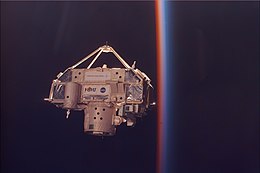This article includes a list of references, related reading, or external links, but its sources remain unclear because it lacks inline citations. (January 2024) |
This article needs additional citations for verification. (January 2024) |
 The CRISTA-SPAS experiment in its ninth and final day of free flight in proximity to Discovery | |
| Names | Space Transportation System-85 |
|---|---|
| Mission type | Research |
| Operator | NASA |
| COSPAR ID | 1997-039A |
| SATCAT no. | 24889 |
| Mission duration | 11 days, 20 hours, 28 minutes, 7 seconds |
| Distance travelled | 7,600,000 kilometres (4,700,000 mi) |
| Orbits completed | 185 |
| Spacecraft properties | |
| Spacecraft | Space Shuttle Discovery |
| Payload mass | 9,191 kilograms (20,263 lb) |
| Crew | |
| Crew size | 6 |
| Members | |
| Start of mission | |
| Launch date | 7 August 1997, 14:41 UTC |
| Launch site | Kennedy, LC-39A |
| End of mission | |
| Landing date | 19 August 1997, 11:08 UTC |
| Landing site | Kennedy, SLF Runway 33 |
| Orbital parameters | |
| Reference system | Geocentric |
| Regime | Low Earth |
| Perigee altitude | 249 kilometres (155 mi) |
| Apogee altitude | 261 kilometres (162 mi) |
| Inclination | 57.0 degrees |
| Period | 89.6 minutes |
 STS-85 mission patch  Left to right – Seated: Rominger, Brown; Standing: Curbeam, Robinson, Davis, Tryggvason | |
STS-85 was the 23rd flight of Space Shuttle Discovery that performed multiple space science packages. It was launched from Kennedy Space Center, Florida, on 7 August 1997. A major experiment was the CRISTA-SPAS free-flyer which had various telescopes on board.